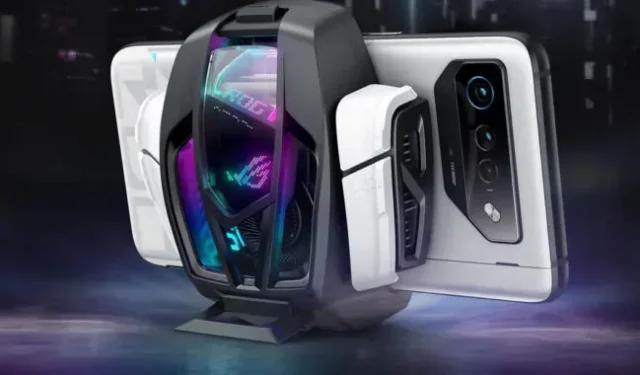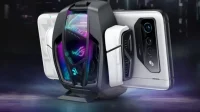Some companies may be ditching the idea of Android gaming phones, but not Asus, which is releasing the ROG Phone 7 today. It has a signature “gaming”design language with a laser beam and pointless LEDs, as well as some really wild engineering additions when it comes to cooling. your super hot gaming phone.
Specs include a Snapdragon 8 Gen 2 SoC, 16GB of RAM, 512GB of storage, and most importantly, a 6,000mAh battery with 65W charging. The display is a 6.78-inch Samsung AMOLED display at 165Hz with a resolution of 2448×1080. The phone has two USB-C ports, one on the side and one on the bottom, as well as a headphone jack. There are three rear cameras, a 50MP main camera, a 13MP wide-angle camera, a 5MP macro camera, and a 32MP front-facing camera.
There are two models here: ROG Phone 7 and ROG Phone 7 Ultimate. The specifications are the same; it ends up just adding a “ROG Vision”rear display. It’s a 2-inch OLED display with six different modes to show things like the time, battery level, an incoming call, or some purely aesthetic animations. The Ultimate model also works better with the AeroActive Cooler 7 attachable fan.
Asus’ extreme cooling ideas are what really make this a gaming phone. Asus says the phone has a “revolutionary new fast cycle vapor chamber design that increases heat dissipation efficiency by 168 percent”compared to the latest ROG phone, which already had better-than-usual cooling.
If you really want to keep your phone cool, there’s a bulky, clip-on backpack with active cooling called the “AeroActive Cooler 7”. It comes bundled with the Ultimate model and is currently a free pre-order add-on for the base model. In the base model, an attachable fan will blow over the back and front glass of the phone. When the goal is to cool the chip under all that glass, cooling the glass isn’t going to be the most efficient thing in the world. However, the Ultimate model opens an electronically controlled hatch on the body of the phone, revealing a set of copper fins attached to an internal cooling plate. The trap door will direct air away from the clip phone onto the stack of fins, at which point you are getting close to
But wait, that’s not all. This fan is so serious that it can use external power. Slower settings will run on your phone’s battery, but for faster settings like “frozen”you’ll need to plug your phone into a power source. Asus also says that the fan backpack has a thermoelectric cooler, which again sounds like it only cools the glass. This all sounds very impressive, but unfortunately Asus doesn’t share exact statistics on what to expect in terms of lower SoC temperatures. The company promises “reducing back panel temperatures by up to 25°C”, but cooling the rear glass panel is not the goal. Glass is an insulator. We want to cool the SoC.
Having a large open flap on the back of the phone isn’t great for water resistance, so naturally it only has an IP54 water resistance rating. This means that it is not even dustproof, but only protected from “splashes”of water. It can probably hold a few ml of water if you really want to try it.
The clip-on cooler is not just a cooler. The four white sections on the cooler are physical buttons that you can press with your index fingers. It also has a subwoofer, a USB-C port (for charging and additional power modes), a headphone jack, and a set of two pins for disconnecting your phone’s battery when you’re not plugged in.
The body of the phone itself also has touch sensitive shoulder buttons called “air triggers”. Air triggers support a host of gestures such as pressing, sliding, or holding a button, as well as performing some kind of gyroscopic movement, such as tilting left or right.
The phone will eventually go on sale in the US, but not until the second quarter. It is currently open for pre-order in Taiwan, Hong Kong and Europe. The base model is 999 euros ($1,104), while the Ultimate model with a rear screen and fancy cooler is 1,399 euros ($1,266).


